ODAA6
Session assets
Orals: Tue, 20 Sep, 15:30–17:00 | Room Andalucia 1
1. Introduction
University students with a strong interest on exoplanets who are willing to engage in astronomical research with telescopic observations face challenges since many higher education institutions are located in areas with poor observing conditions. Traditionally, a small number of students are given the opportunity to travel to an observatory, but lack of funding in most institutions in combination with pandemic related travel restrictions led to a further reduction of such observation excursions. Having said that, remote observing capabilities can offer access to telescope facilities and can also be used for educational purposes. However, remote observing requires a coordinated approach including the scheduling and the tools used to obtain integrated scientific results.
Open science projects, such as the ExoClock project can be used as a tool to educate students and engage them with exoplanet research. This provides an excellent chance for university students to undertake cutting-edge science that also has a meaningful impact on a future space mission.
2. ExoClock Project
ExoClock is an international and educational project for exoplanet enthusiasts around the world with the primary goal of monitoring transiting exoplanets and keeping their respective ephemerides up-to-date. The project promotes the idea that research is an effort that everyone can contribute and, thus, it is open to collaborations with amateur astronomers and encourages the participation of school and university students.
To facilitate this, user-friendly tools and a dedicated website have been developed as part of the project. The website includes audiovisual educational material, data analysis tools, instructions, observational data and graphics [1,2]. All sources are online, free, and available for everyone. ExoClock aims to facilitate a coordinated programme of ground-based observations to maximise the efficiency of the Ariel space mission aiming to observe 1000 exoplanets and characterize their atmospheres [3].
3. Las Cumbres Observatory
ExoClock in collaboration with the Las Cumbres Observatory (LCO) provided us with observing time to obtain some exoplanet transits while priority was given to participants and especially students and pre-amateur astronomers that didn't have access to equipment. We utilized the LCO network’s ground-based 0.4 m robotic telescopes [4], with access provided via the ORBYTS programme (Original Research by Young Twinkle Students); an educational research programme working in collaboration with ExoClock [5].
The LCO network consists of six sites which host 0.4 m (roughly 16 inches) telescopes which are spread across both the northern and southern hemispheres as shown in Figure 1. Specifically, we utilized the 0.4 m telescope at Cerro Tololo Observatory located in Chile, (lat, lon) = (-30.2°, -70.8°), using its imaging mode and the SDSS-rp filter.
Figure 1
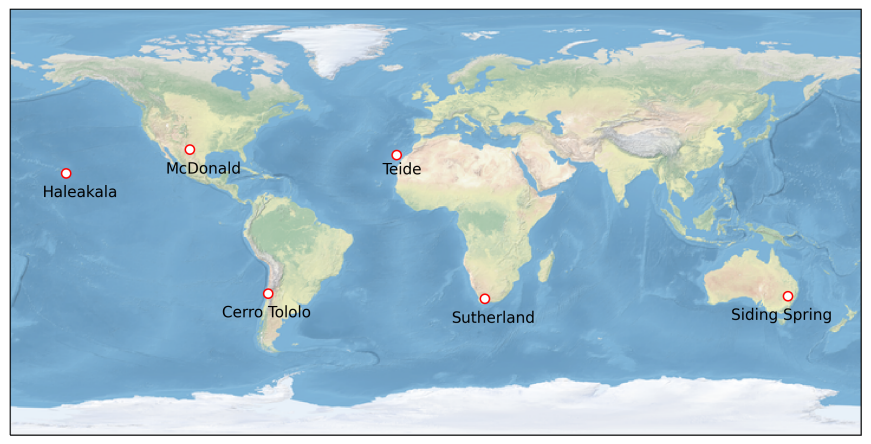
4. Methodology
By loading in the size and location of the telescope, the ExoClock platform provides a scheduler with a list of potential observations over the coming days; an example of this schedule is shown in Figure 2.
Figure 2
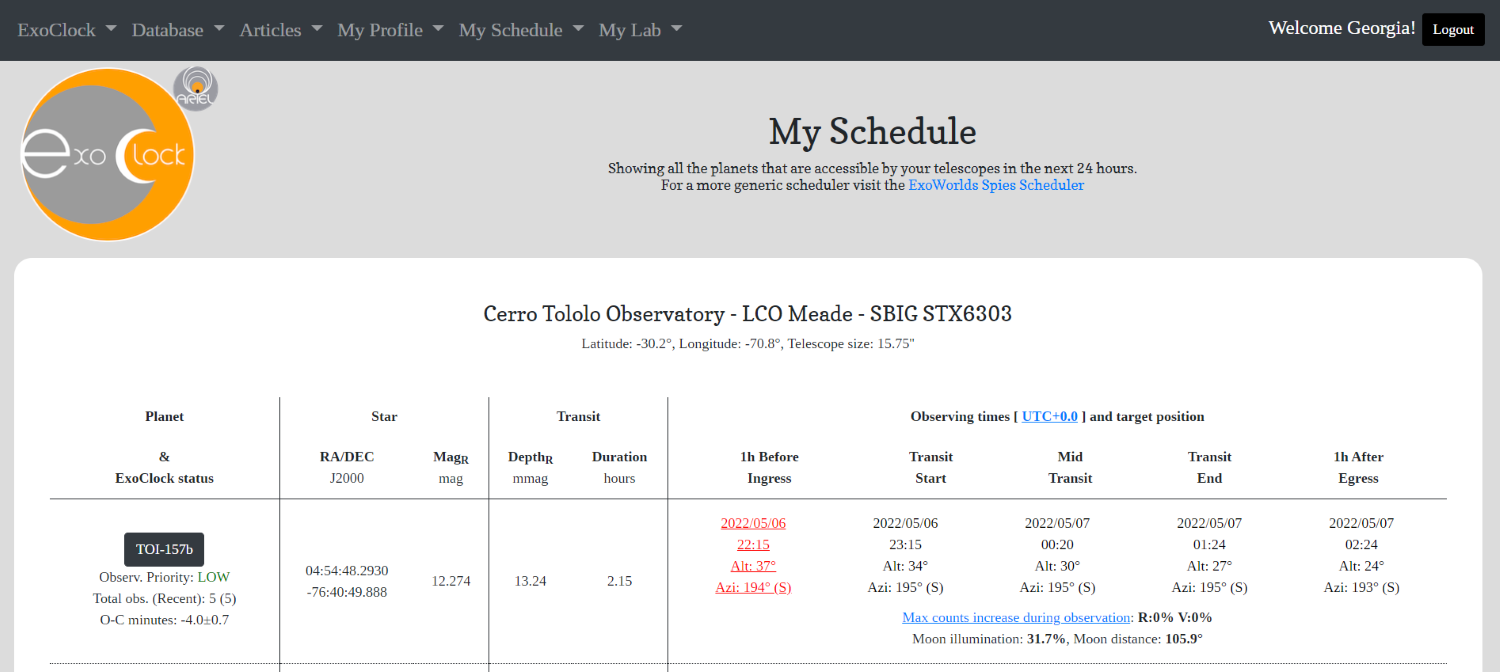
We chose to observe the exoplanet HATS-10b which is indicated as a target with alert priority due to a significant shift in the ephemeris that was found a year ago by another ExoClock member. The choice of target was also restricted by the star magnitude and transit depth but also due to the transit duration.
The data were obtained from the LCO archive and analysed by using the HOlomon Photometry Software (HOPS) [7], which is an interactive user-friendly tool, for reduction, alignment, photometry and light curve extraction. This software is open-source and available on Github (https://github.com/ExoWorldsSpies/hops).
Figure 3
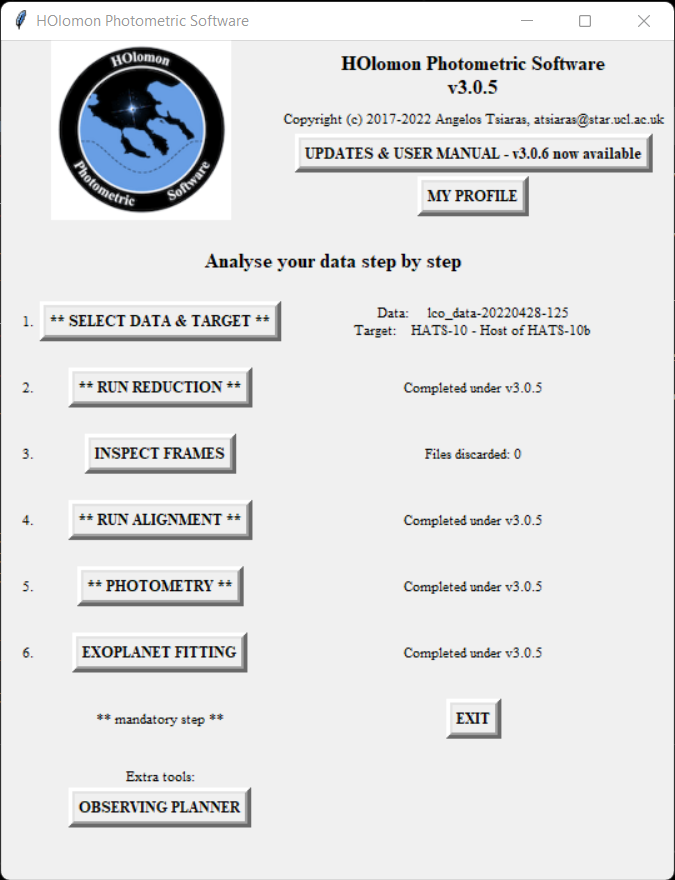
The LCO portal was also developed to be user-friendly with graphics and instructions and provided documentation for inexperienced users. A screenshot of creating an observation request in the LCO portal is shown in Figure 4.
Figure 4
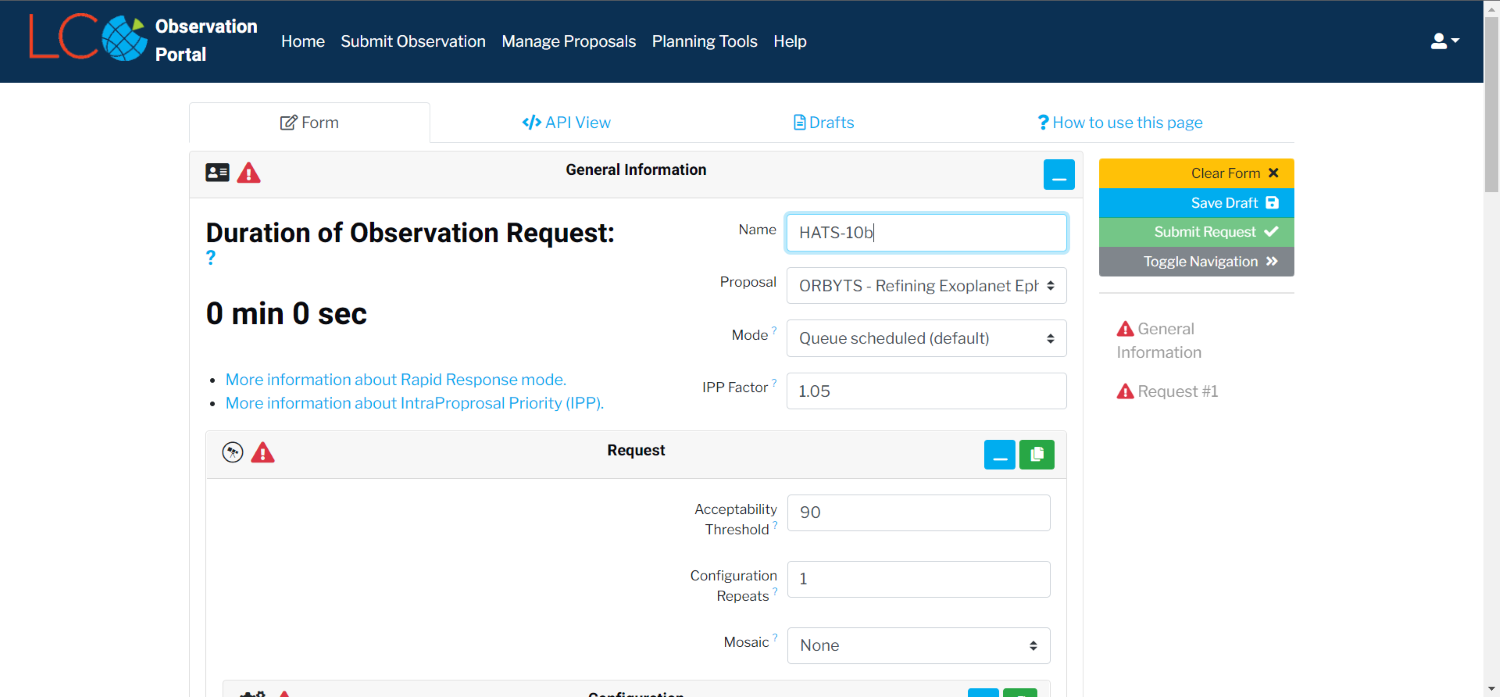
5. Results & Discussion
We acquired data for the transit of the planet HATS-10b on the 28th of April 2022, as shown in Figure 5. The light curve covers the full transit duration, plus a baseline of up to toughly half the transit duration. Our results suggest that there is a shift in the timing of the transit and it occurs approximately ~28 minutes earlier than it's literature ephemeris. This result is consistent with previous results by another ExoClock member, giving us confidence that the deviation from the literature ephemeris that we find is correct.
The planet is potentially a viable target for atmospheric characterisation and our data, which were taken using the LCO network of ground-based telescopes, will be combined with observations from other users of ExoClock to ensure that the transit times of these planets continue to be well-known, far into the future. As TESS and other surveys continue to find planets, ephemeris refinement projects will become ever more important and educational outreach and open science programmes have the potential to play a large role in maintaining transit times for the next generation of telescopes [5].
Figure 5
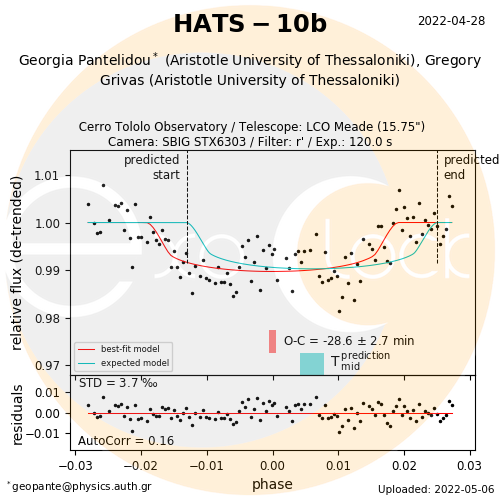
6. Benefits from our experience
Through the ExoClock project undergraduate students have a unique opportunity to contribute to an upcoming ESA mission. One of the main benefits of this experience is that those involved not only acquire the theoretical background needed but also actively participate in real scientific research by obtaining and analyzing astronomical data, under proper supervision and guidance; that otherwise might not have the chance to experience during their undergraduate studies. In this way, university students cultivate a scientific mindset by obtaining and reviewing scientific results and improve their computational skills. At the same time, they develop new soft skills regarding observatory operations and regulations, communicating and cooperating with fellow observers while getting specialized knowledge in planetary sciences in an appealing and interactive manner.
Additionally, outreach activities in open science projects can provide to university students a first look of the research environment by experiencing research in practice and can help them choose their future career. After all, experience and skills gained from hands-on opportunities such as the ones provided from ExoClock are highly aligned and greatly valued in today's academic and business environments [8].
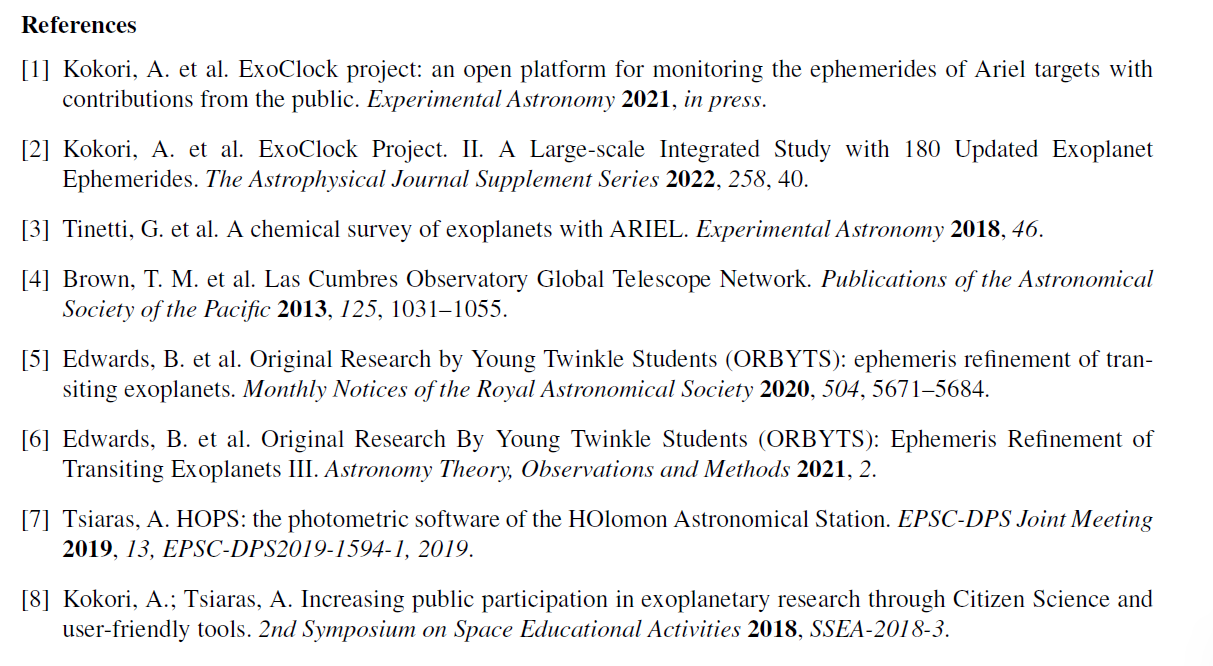
How to cite: Pantelidou, G., Grivas, G., Lekkas, G., and Kokori, A.: Observing exoplanets without equipment, experiences from university students, Europlanet Science Congress 2022, Granada, Spain, 18–23 Sep 2022, EPSC2022-214, https://doi.org/10.5194/epsc2022-214, 2022.
The aim of this talk i s to present “Sorvegliati Spaziali – know the Space to protect the Planet”, a public dissemination project of the Italian National Institute for Astrophysics (INAF) dedicated to the Planetary Defense: from near Earth asteroids and comets to space weather, from meteors and meteorites to space debris, as well as prevention/mitigation strategies of their possible effects on the Earth environment.
Sorvegliati Spaziali represents one of the first coordinated public outreach initiatives on such topics by a research body and its main objective is to provide scientific and cultural knowledge to convey how our Planet is exposed to various natural and man-made threats in Space, as well as our current plans for response to them, meanwhile rowing against the many fake news about Planetary Defense that has biased the collective imagination.
The core of the project is the Italian entirely graphic and multimedia website sorvegliatispaziali.inaf.it available online since October 2021 (translation in English in progress), which intends to become a national point of reference for information and in-depth content on Planetary Defense, timely disseminating scientific and cultural knowledge through a variety of original state-of-the-art multimedia information products, meanwhile relaunching news from other national and international research bodies.
INAF original products, including the project website, are characterized by a strong and consistent visual identity and are: educational video-clips, interviews to scientists, geolocalized map with live satellites tracking, augmented reality and 3D computer graphic content, video-recorded theatrical pills, solar and Near Earth objects bulletins, infographics, a glossary.
It is moreover foreseen the organization of a multimedia public event on the occasion of the Asteroid Day 2022 including a round table, movie screenings and a meteorites exhibition.
The project is developed in collaboration with external research institutions, web design and professional theatrical companies and is endorsed by the Outreach Office of the NASA Planetary Defense Coordination Office.
The figure below illustrates part of the homepage of the website sorvegliatispaziali.inaf.it
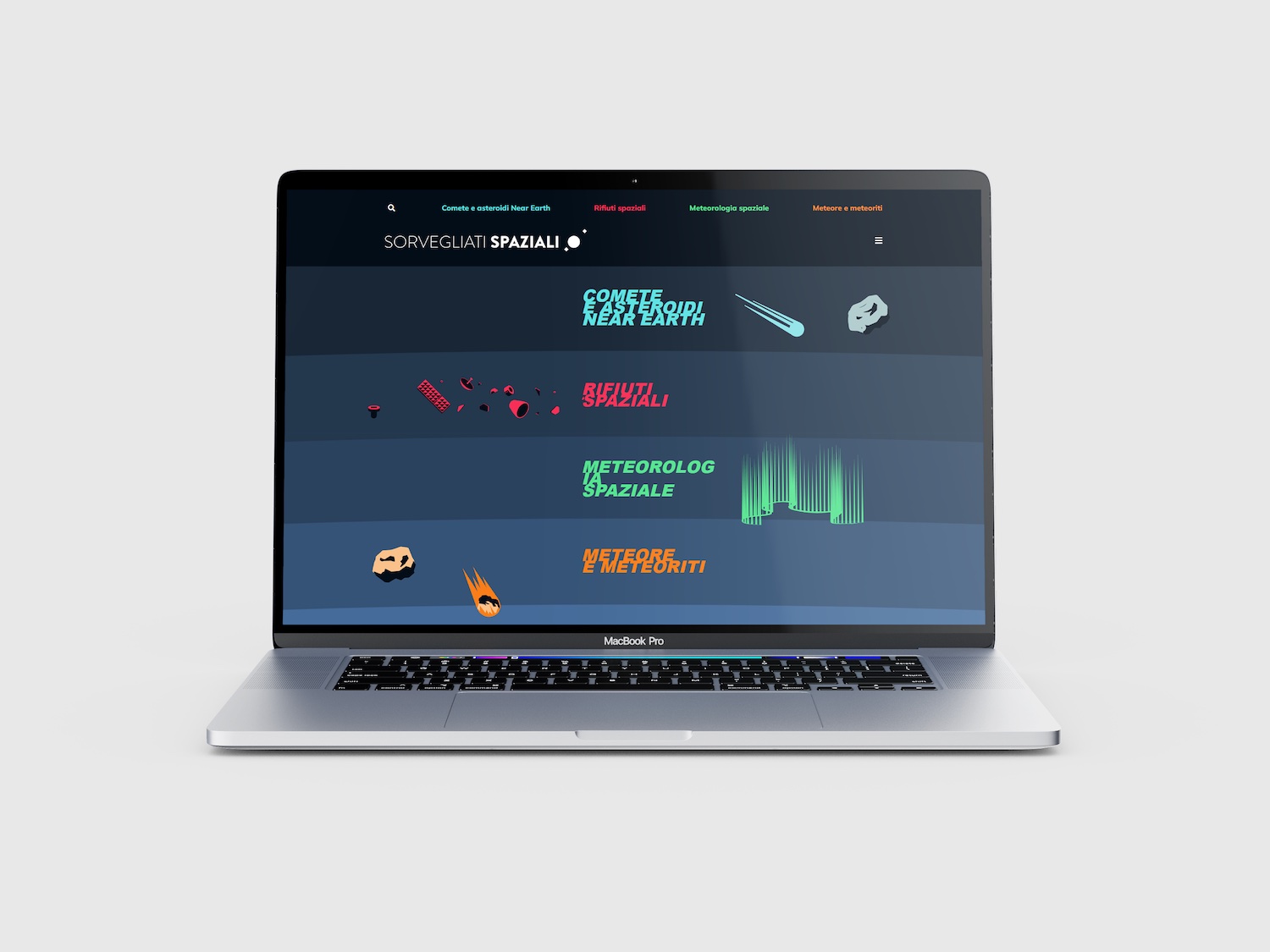
.
How to cite: Guidetti, D., Boccato, C., Coero Borga, D., Galliani, M., Gardiol, D., and Soletta, P.: Sorvegliati Spaziali:an innovative outreach project on Planetary Defense, Europlanet Science Congress 2022, Granada, Spain, 18–23 Sep 2022, EPSC2022-579, https://doi.org/10.5194/epsc2022-579, 2022.
Introduction: International Observe the Moon Night is a worldwide public engagement program that has been held annually since 2010. Every autumn, we ask people to observe the Moon and learn about lunar science and exploration. The event occurs when the Moon is in or near a first-quarter phase, which provides excellent viewing opportunities along the terminator (the line between night and day), as long shadows place lunar features into great relief.
Hundreds of thousands of individuals all around the globe participate in the event as a collective whole, learning about lunar science and exploration, taking part in celestial observations, and honoring cultural and personal connections to the Moon. People participate in a variety of ways, including hosting or attending virtual or in-person events and observing the Moon from home. Participants also have the opportunity to connect with other lunar observers around the world through our Facebook page (facebook.com/observethemoon/), our Flickr group, and through the hashtag #ObserveTheMoon across social media platforms.
Getting Involved: It is incredibly easy to be a part of International Observe the Moon Night, whose 2021 program saw an estimated 500,000 participants from all 7 continents, 122 different countries, all 50 U.S. states, Guam, Puerto Rico, the U.S. Virgin Islands, and Washington, D.C. [1].
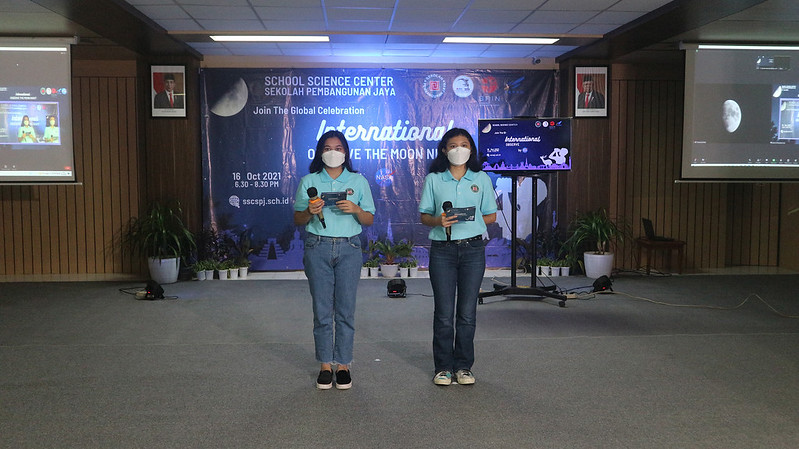
Figure 1: An International Observe the Moon Night 2021 event in Indonesia. Image credit: School Science Center Sekolah Pembangunan, https://flic.kr/p/2mBTEkC
Registration. There are multiple entryways into participating in International Observe the Moon Night. Our website contains a page dedicated to registration, where people can search for events that are already planned (both in-person and virtual), register their own events, or sign up as individual lunar observers. Events can be scheduled anytime in the two-week period surrounding the main International Observe the Moon Night date which allows for better accommodation for event hosts and participants.
Bringing Science to Local Communities. International Observe the Moon Night provides an opportunity to come together to learn about the wonders of lunar and planetary exploration. It is also a great way for scientists to share lunar science with their communities and to connect with community partners. Collaborating at the community level encourages a more diverse and inclusive environment for participants.
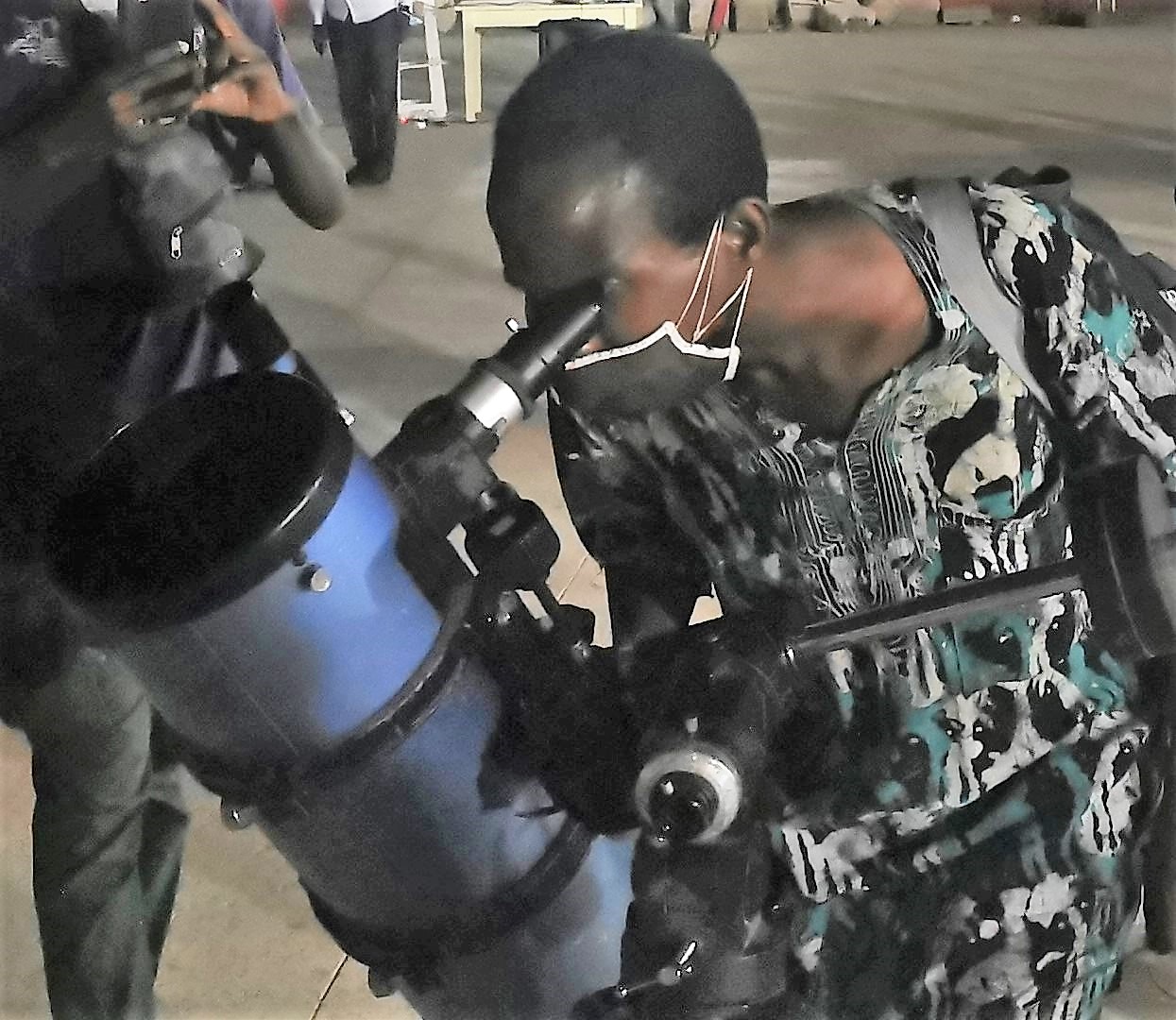
Figure 2: An International Observe the Moon Night 2021 participant in Senegal. Image credit: Sylvain Bouley/ASPA, https://flic.kr/p/2mEm6HS
Highlighting Current Moon News: The present time is an especially exciting one for lunar science and exploration. With the first Commercial Lunar Payload Services (CLPS) instruments planned for launch this year and NASA’s Artemis program in full development, International Observe the Moon Night offers a great opportunity to discuss these missions and the future of lunar exploration. It also provides a chance to reflect on previous Moon missions, with the 50th anniversary of Apollo 17 coming up this December.
Supporter Involvement: Our supporters help make International Observe the Moon Night what it is today through assistance with translations of materials, spreading the word about the event through their various networks, ideas for new resources, and overall program feedback.
Global Moon Party. In 2021, members of the International Observe the Moon Night Coordinating Committee and the Night Sky Network hosted a Global Moon Party which featured three hours of live streamed content, including presentations, demonstrations, and stories about the Moon [2]. One of our supporters from the Virtual Telescope Project in Italy was a guest presenter during the program, discussing how and why he participates in International Observe the Moon Night and offering views of the Moon alongside iconic Italian landmarks.
Featured Observer. We developed a new feature on our website in 2021, where our International Observe the Moon Night supporters, event hosts, and observers from around the world are highlighted. This is a space where they have an opportunity to discuss a variety of topics, from what the Moon means to them to how they became involved in International Observe the Moon Night to tips for other participants.
Thus far, we have discovered more about our supporters from the Japanese Space Exploration Agency and the Federation of Spanish Astronomical Associations and look forward to highlighting additional participants in the future.
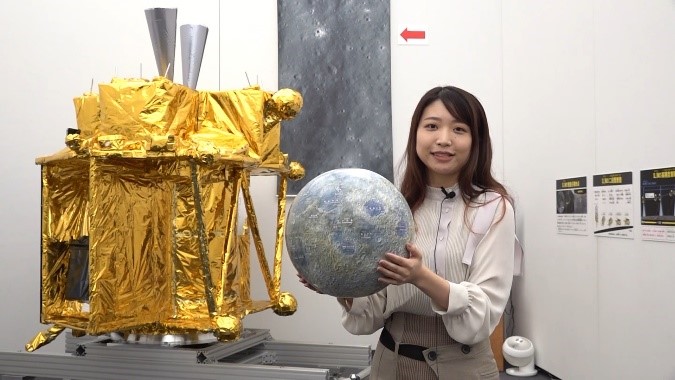
Figure 3: A joint exhibit on the Moon with the Japanese Space Exploration Agency and the Sagamihara City Museum. Image credit: JAXA/ISAS
Observe the Moon Video. In order to highlight the diversity of people involved in International Observe the Moon Night, we sent out a request to our supporters for brief video clips about how they say “observe the Moon” in their native language, their favorite thing about the Moon, and other Moon-related content. The result was a short video conglomeration of people around the world discussing the Moon [3]. We plan on continuing this endeavor for this year’s event as well.
2022 Event: Join us for the next International Observe the Moon Night on Saturday, October 1, 2022.
NASA TV Broadcast. In 2020, circumstances of the pandemic directed us to incorporate more virtual event opportunities, resulting in our first NASA TV broadcast. We continued this effort in 2021 and will do so again for this year’s program, providing people around the world the ability to celebrate the event with NASA.
International Observe the Moon Night is an established program, but we are always looking for new collaborators, participants, and ideas for engagement. This is an opportunity for people all around the world to be part of a successful public engagement program. Additional information about the event can be found at moon.nasa.gov/observe.
Acknowledgements: International Observe the Moon Night is sponsored by NASA’s Lunar Reconnaissance Orbiter (LRO) mission and the Solar System Exploration Division at NASA’s Goddard Space Flight Center, with many contributors and supporters.
References: [1] Barry, C. et al.: Everyone, Everywhere, Every Year: Highlights from International Observe the Moon Night 2021, LPSC, 7-11 March 2022, The Woodlands, TX, USA.
[2] Global Moon Party – Kickoff International Observe the Moon Night 2021, youtube.com/watch?v=v61JyMG_zMs
[3] International Observe the Moon Night 2021, https://www.youtube.com/watch?v=GODxYZMueoQ
How to cite: Tiedeken, S., Jones, A., Wasser, M., Barry, C., Nguyen, V., Buxner, S., Bakerman, M., Beaudoin, G., Fooshee, J., Day, B., Gay, P., White, V., Summer, T., Joseph, E., and Cokinos, C.: Celebrate Lunar Science and Exploration with NASA's International #ObserveTheMoon Night, Europlanet Science Congress 2022, Granada, Spain, 18–23 Sep 2022, EPSC2022-656, https://doi.org/10.5194/epsc2022-656, 2022.
Although the apparition of the Open Science policy at European level in 2018 is expected to trigger a sharp increase in scientific activity, is it a challenge to the community. Most notably, data related to publications or produced during programmes funded on public money (such as H2020 / Horizon Europe, and national programmes) now need to be made accessible according to FAIR principles. Beyond easy availability of published articles, the principle of open access to the data, may result in an increase in spending that would mainly benefit private editors.
However, mature solutions to this problem exist in the academic world, which are not only economical and rewarding, but also accessible to small research teams. These solutions also have applications to citizen science and pro-amateur projects.
The Virtual Observatory. VESPA (Virtual European Solar and Planetary Access) has focused for 10 years on adapting Virtual Observatory (VO) techniques to handle Planetary Science data [1] [2]. The objective of this activity is to build a contributory data distribution system both to access and publish data with minimum fuss. This system is responsive to the new paradigm of Open Science and FAIR access to the data, and is optimized to publish data with limited resources. VESPA therefore relies on an infrastructure maintained by the astronomical community, and enlarges it to support Planetary Science by publishing additional standards, increasing compliance with other fields (Earth observation, heliophysics, space physics…), and adding new capacities to existing tools.
Data description and access. VESPA uses a standard access protocol called TAP, associated with a metadata vocabulary providing uniform description of datasets in the field (EPN-TAP). At the time of writing EPN-TAP is in the final stage of becoming a Recommendation of the International Virtual Observatory Alliance (IVOA) [3]. Many tools can search data services based on EPN-TAP, in particular the VESPA portal (http://vespa.obspm.fr), generic VO clients, and VO tools which also provide visualisation and processing functions (e.g. TOPCAT, Aladin, CASSIS for tabular data, images, and spectra). Specific access modes (via script, web services, Jupyter notebook, etc) are also available for advance usage. The VESPA portal is intended as a discovery tool that queries all EPN-TAP services together. It provides a convenient way to search archives described with the EPN-TAP metadata vocabulary, to cross-search many databases, and to send selected data products to generic, high-level visualization and processing tools maintained by the astronomy community.
Practical implementation relies on 60+ published data services from 20+ institutes, offering a variety of situations. The recommended method consists in the installation of a data server supporting EPN-TAP, which is available in a Docker container and can easily be deployed anywhere. This only requires permanent web connection and URL for the server, and it takes advantage of a global infrastructure supported by the community (registry of services and VO tools). Generic tutorials are available for easy implementation – in a typical situation, data ingestion only requires a CSV list of data products described by the EPN-TAP parameters, although existing databases can be used to build a data service.
Service publication is granted by simply declaring it in a common registry. The data themselves can be located anywhere, either locally or on public storage facilities such as Zenodo or B2SHARE (where VESPA communities have been declared).
Contributory science. VESPA already distributes archives from pro-amateur collaborations, in particular PVOL for planetary images, but also RadioJove for radio observations of Jupiter (NASA-supervised project). Such archives are very helpful to complement professional surveys by filling gaps at several time scales with observations from multiple locations.
A number of collaborative projects are discussed in the frame of Europlanet 2024 RI (NA2 activity), including: the telescopic network (test server already installed); fireball networks (individually or with a common data distribution facility); observations of comets.
Public availability and easy, structured access to the data obviously have potential applications to teaching and outreach.
Access to derived data and science results. Although observatories and space agencies have open archives, they are usually limited to raw or calibrated products, and do not include science-ready data published in articles. ESA’s Planetary Science Archive as an EPN-TAP interface, as well as several ground-based facilities. Existing repositories of derived data include the ESA Guest Storage Facility (hardly searchable currently) and VizieR catalogue of article tables relevant to Solar System studies (available as an EPN-TAP service).
Support. In the frame of the Europlanet 2024 RI programme at least, the VESPA team gladly provides support to users and potential data providers. This of course is intended to become a community infrastructure and to outlive the Europlanet programmes.
The Europlanet-2024 Research Infrastructure project has received funding from the European Union's Horizon 2020 research and innovation programme under grant agreements No 871149.
[1] Erard et al 2018, Planet. Space Sci. 150, 65-85. 10.1016/j.pss.2017.05.013. ArXiv 1705.09727
[2] Erard et al. 2020, Data Science Journal 19, 22. doi: 10.5334/dsj-2020-022.
[3] https://ivoa.net/documents/EPNTAP/
How to cite: Erard, S. and the VESPA team: Open Science policy and Solar System data: contribution from Europlanet/VESPA, Europlanet Science Congress 2022, Granada, Spain, 18–23 Sep 2022, EPSC2022-1116, https://doi.org/10.5194/epsc2022-1116, 2022.
Introduction
In this contribution we present the EXPLORE Horizon 2020 Research & Innovation project and the new tools and services it is providing to promote scientific exploitation of planetary and astrophysical data. EXPLORE's main objective is to develop and deploy a suite of scientific data applications (SDAs, aka Apps) for Lunar exploration and Gaia. EXPLORE is placed in a broader landscape of open science platforms and initiatives such as the European Open Science Cloud [1]. Our ambition is to support and accelerate space science exploration and exploitation with open data and open science.
EXPLORE platform
To support the development, testing, and demonstration of the SDAs we set-up a virtual platform, https://explore-platform.eu which, in addition to running SDAs for users, also has a space browser to easily find data from selected planetary missions (see Figures below). The final goal is to deploy the SDAs, under open-source licences, on different cloud science platforms where and when possible (e.g. ESA Datalabs [2] and ESCAPE Science Analysis Platform [3]) to stimulate uptake and sustainability of both SDAs and these platforms. The EXPLORE platform could also be used, as a bespoke (application agnostic) service, by research groups / institutions.
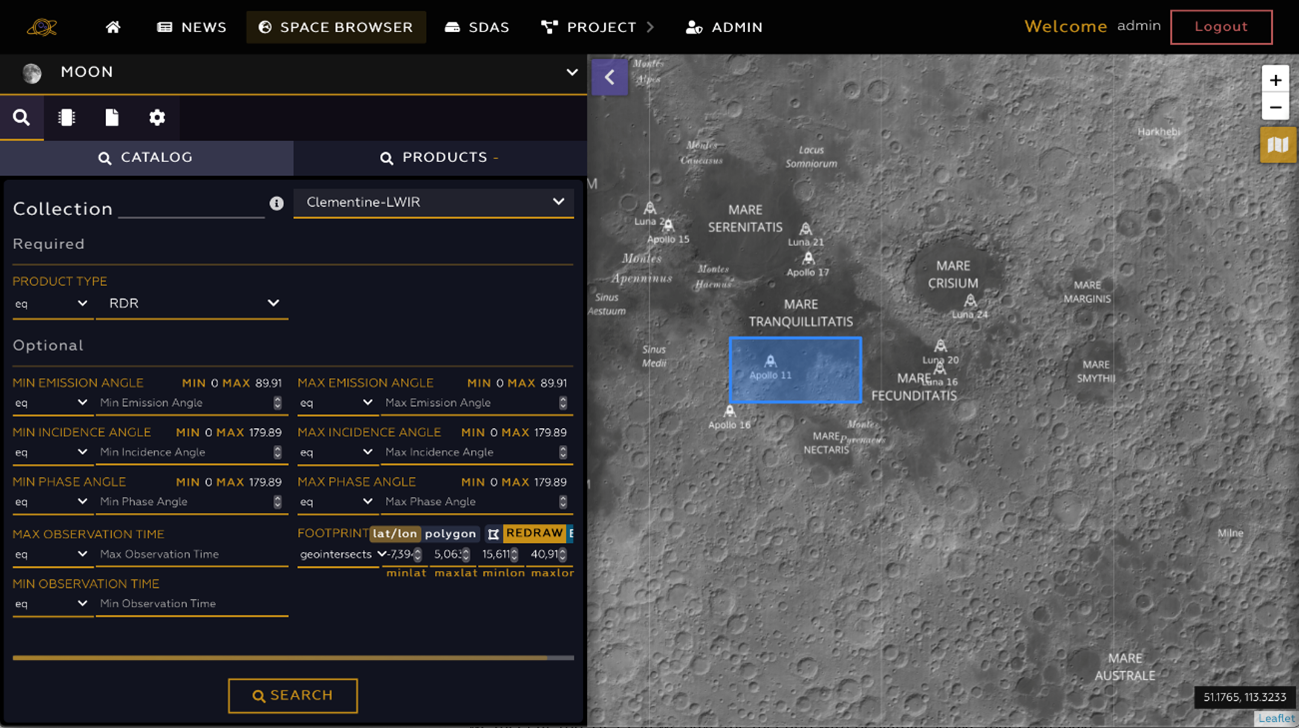
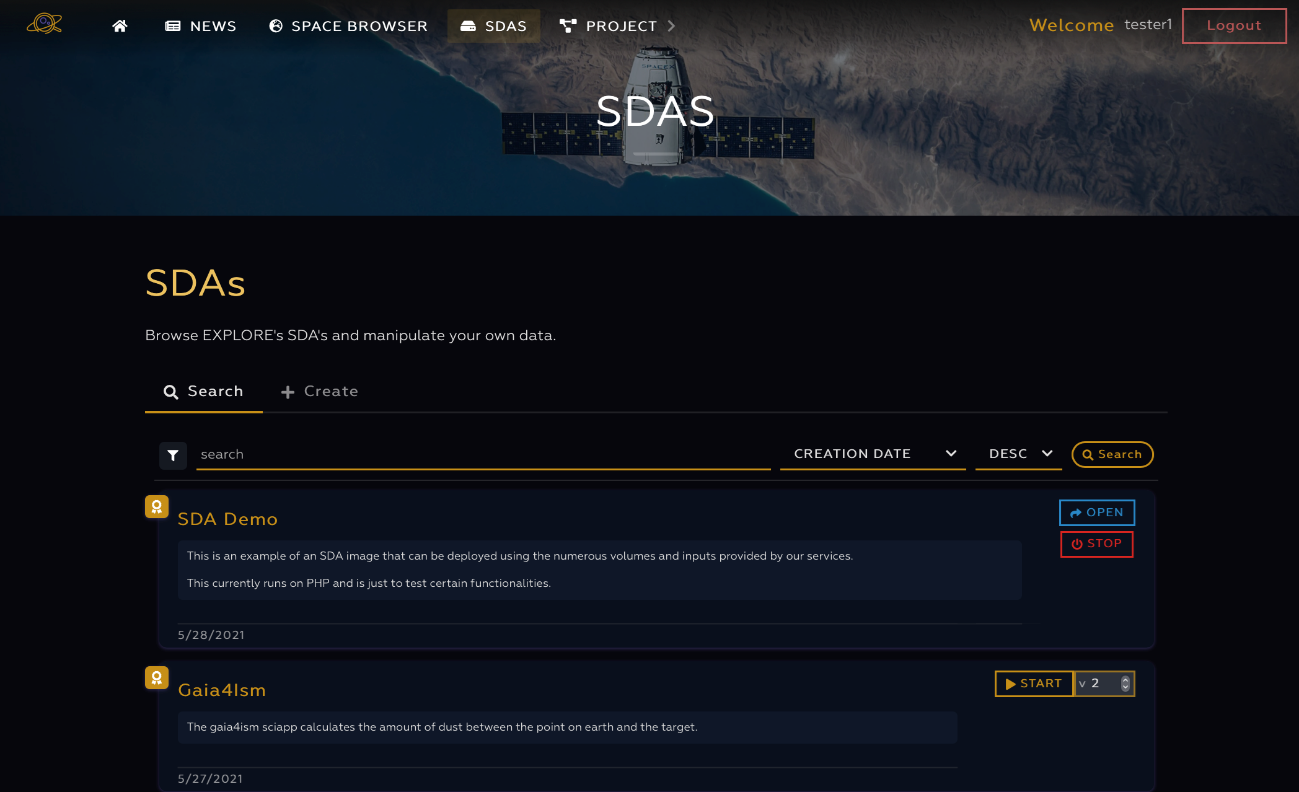
Scientific Data Applications
Within EXPLORE six scientific data applications (SDAs) produce new scientific data products and offer new scientific services. Two applications integrate data from a range of lunar missions to focus on characterisation of the Moon’s surface and potential human landing sites. The other four applications leverage data primarily from Gaia, developing tools to study the evolution of our galaxy (stellar archaeology), interstellar dust clouds, and support the discovery, classification, and characterisation of stars. The SDAs utilise state-of-the-art machine learning and visual analytics to further enhance scientific return and discovery potential of space science missions.
Our SDAs (Apps)
The six (initial) SDAs, from Lunar, stellar to Galactic science are summarised as follows (proto-types on https://explore-platform.eu):
- L-Explo is a service that aims to be complementary to existing initiatives such as Moon Trek [4], QuickMap [5], and Orbital Data Explorer [6]. We focused it on supporting large scale lunar mapping in a 2/2.5D environment. The backend access and queries the ingested higher-level lunar data through WMS standards and custom processing APIs.
- L-Hex focusses on the smaller scale Lunar features that are of interest to local, (human and robotic) exploration, with visualisations extending to 3D. Backend is common to L-Explo. See also [9].
- S-Phot reconstructs stellar spectral energy distributions (SEDs) by collating archival photometric surveys, from UV to infrared, including the Gaia (e)DR3 to derive accurate stellar properties for a wide range of applications such as finding stars with blue or red excess, studying stellar clusters, characterising exoplanet host stars, etc.
- S-Disco brings a new dimension to exploring large spectroscopic, photometric, and astrometric data sets and particularly to the discovery of unusual, anomalous objects, and finding similar objects, through providing new representations and visualisations of higher dimensionality data with machine learning.
- G-Tomo is an application that serves a set of public 3D tomography cubes with different extents / spatial resolutions [7]. It allows to create different visualisations (currently 1D profiles, 2D slices and 3D volume contours) of the galactic interstellar dust cloud distribution (up to 10 kpc extent).
- G-Arch is a sophisticated tool to infer stellar parameters and abundances (Teff, logg, [alpha/H], [Fe/H], etc) from stellar spectra (based on the Matisse software [8]) and providing a suite of visualisations and machine learning analysis functionalities.
Concluding statement
EXPLORE’s ambition is to support and accelerate space science exploration and exploitation with open data and open science. The lunar SDAs are timely in light of the 50th year celebration of the last humans to set foot on the Moon (11 December 2022) and the global renewed interest to visit our celestial sister. The “Gaia” SDAs are also timely with the Gaia DR3 release and the additional data it brings over the earlier eDR3.
Acknowledgments
This project has received funding from the European Union’s Horizon 2020 research and innovation programme under grant agreement No 101004214.
References
[1] Pasian et al. (2020), What can Open Clouds do for Astronomy? Interaction between the ASTERICS and EOSC Projects, ADASS XXVII, 522, 707
[2] Arviset et al. (2021), ESA Datalabs: Towards a collaborative e-science platform for ESA, LPI Contributions, 2549, 7014.
[3] Allen et al. (2020), ESCAPE – addressing Open Science challenges, arXiv:2012.11534
[4] Law et al. (2021), Feature detector on the Moon Trek Portal, EPSC2021-151, doi:10.5194/epsc2021-151
[5] QuickMap help, https://docs.quickmap.io
[6] Wang et al. (2021), Planetary data search with PDS geosciences node’s Orbital Data Explorer, LPI Contributions, 2549, 7025
[7] Lallement et al. (2022), Updated Gaia-2MASS 3D maps of Galactic interstellar dust, arXiv:2203.01627
[8] Recio-Blanco et al. (2006), Automated derivation of stellar atmospheric parameters and chemical abundances: the MATISSE algorithm, MNRAS, 370, 141
[9] Cox et al. (2022), EXPLORE – Innovative Scientific Data Exploration and Exploitation Applications for Space Sciences – The lunar case, 6th Planetary Science Informatics and Data Analytics Conference 2022.
How to cite: Cox, N., Rossi, A. P., Nodjoumi, G., Poznanski, D., Eilat-Bloch, Y., Recio-Blanco, A., Zijlstra, A., McDonald, I., Rauch, M., Sabol, V., Heward, A., Corrato, G., Genot, A., Bernard-Salas, J., and Mangin, A.: EXPLORE - Innovative Scientific Data Exploration and Exploitation Applications for (Planetary) Space Sciences, Europlanet Science Congress 2022, Granada, Spain, 18–23 Sep 2022, EPSC2022-507, https://doi.org/10.5194/epsc2022-507, 2022.
The ExoClock Project (www.exoclock.space) is an open, integrated, and interactive platform, designed to maintain the ephemerides accuracy of the Ariel targets. Ariel is ESA's medium class space mission prepared for launch in 2029. The main aim of the mission is to characterise a large number of exoplanets to better understand their nature. ExoClock aims to provide transit mid-time predictions for Ariel by collecting all currently available data (literature observations, observations conducted for other purposes, both from ground and space) and by efficiently planning dedicated efforts to follow-up the Ariel targets. ExoClock is open to contributions from a variety of audiences professional, amateur astronomers, university students and industry partners aiming to make the best use of all available resources towards delivering a verified list of ephemerides for the Ariel targets before the launch of the mission. In this presentation the organisation and the current status of the ExoClock project will be described. In addition, strategies and tools that are used to enable open science will be presented. Finally, the results will be presented from almost three years of operation of the project.
How to cite: Kokori, A.: The ExoClock Project: an open integrated platform for maintaining the Ariel target ephemerides with contributions from the public, Europlanet Science Congress 2022, Granada, Spain, 18–23 Sep 2022, EPSC2022-424, https://doi.org/10.5194/epsc2022-424, 2022.
The field of exoplanets is one of the most rapidly growing, with more than 5000 planets discovered to date. Follow-up observations of Exoplanets is one of the few fields of astronomy that small telescopes can still contribute to ongoing research. In fact, observations with small and medium scale telescopes are becoming more and more popular among amateur astronomers, students and early career scientists as they do not require sophisticated instrumentation. However, an important barrier between observing and producing scientifically valid results is the data analysis and modelling. To assist observers towards this aspect and make it possible for more people to contribute to scientific research I have developed a series of open-source pieces of software that support the work of inexperienced observers. In my presentation I will talk about the importance and the impact of open-source software and I will also present HOPS, a python-based package which includes a user interface and it is compatible with Linux, OS X and Windows. HOPS is designed to analyse data from small and medium class telescopes. HOPS is a user-friendly package where graphic representations, statistics and models are brought together into a single package. With these characteristics, HOPS can be used by amateur astronomers individually or as part of citizen science projects or as an educational for university or school students.
How to cite: Tsiaras, A.: Enabling participation in exoplanet research with open source tools, Europlanet Science Congress 2022, Granada, Spain, 18–23 Sep 2022, EPSC2022-919, https://doi.org/10.5194/epsc2022-919, 2022.
Introduction: OpenPlanetary, or simply "OP", is an international non-profit organisation that promotes open research in the planetary science and exploration communities: sharing ideas and collaborating on planetary research and data analysis problems, new challenges, and opportunities [1].
OpenPlanetary started in 2015 as a way for participants of the ESA’s Planetary GIS Workshop to stay connected and exchange information related to and beyond this workshop. It expanded further by playing a similar role for the second USGS-hosted Planetary Data Workshop (PDW) in 2017. OpenPlanetary has continued to support the biannual PDW and provides a more persistent forum for participants to highlight presented topics and discussions from the workshops.
In 2018, we established OpenPlanetary as a non-profit organisation (Association under 1901 French Law, [2]) in order to provide us with a legal framework to sustainably fund our community framework, projects and activities, and to better serve the planetary science community as a whole. OpenPlanetary is governed by a Board of Directors, elected for two years, which (1) define the policy and general orientation, (2) initiate, endorse, lead, or contribute to the projects and activities, and (3) can make use of the funds of the Association for any endorsed project or activity; the Bureau contains a 3-person subset of the Board members (a president, treasurer, and secretary) and serves as the executive body of the Association.
Mission: Our mission is to promote and facilitate the open practice of planetary science and data analysis for professionals and amateurs. We do so by organizing events and conducting collaborative projects aimed at creating scientific, technical and educational resources, tools and data accessible to all.
Members and Membership: With currently 300+ members across the world, OpenPlanetary membership is free and open to research and education professionals: scientists, engineers, designers, teachers and students, space enthusiasts and citizen scientists [3]. Although the early membership had a strong representation in planetary surface and mapping sciences, OpenPlanetary has expanded and is intended to serve as an “umbrella” for all communities of planetary data and tool users, producers or providers across scientific disciplines, space missions or working groups.
Collaboration Platform: Our collaboration platform mainly consists of fully-featured Slack and Github instances. OP members use OP Slack workspace to stay connected and have real-time discussions with other members [4], and are entitled to request admin rights to host and manage open source projects on OP Github organization [5].
Online Forum: We provide a public online OP Forum for research professionals and amateurs across all planetary science disciplines and communities to find help, share and discuss data, tools and resources [6]. While OP Slack is considered for the more informal discussions, the OP Forum is intended to post Q/A and discussion ”gems'' from OP Slack, or any resources that would help a broader community (eg: a short tip, a handy how-to guide or a list of curated resources), and that would benefit from having a permanent web-presence and being discoverable by search engines.
Data Cafés: Since 2017, we have organised Data Cafés at scientific conferences for people to meet, share, discuss and solve common challenges and issues related to planetary data handling and analysis. These events follow an "unconference" format allowing and encouraging anyone to propose a topic and lead a group activity (eg: demo, tutorial, hack), or simply to ask for help [7].
Online Events: Unable to continue with the in-person Data Cafés in 2020, we started hosting virtual online events: (1) OPvCon in June 2020 was our first free virtual conference, scheduled in place of the cancelled Planetary Science Informatics and Data Analytics Conference (PSIDA). It consisted of lecture-length talks from invited speakers, networking opportunities, workshops and tutorials, and a hackathon [8], and (2) since March 2020, we have hosted weekly OP Lunch Talks to present and discuss technical topics of interest to the planetary science community [9]. Most of these events are recorded and made publicly available on YouTube. They now represent a substantial collection of high-quality informational resources and training videos on diverse topics related to planetary science [10].
Community Projects: Our flagship project is OpenPlanetaryMap (OPM), an open planetary mapping and social platform and effort to foster planetary mapping and cartography on the web for all [11]. We also support PlanetaryPy, a community effort to develop a core package for planetary science in Python and foster interoperability between Python planetary science packages [12]. A number of other projects not strictly homed under the OP umbrella have arisen from collaborations fostered in OP Slack or during OP Lunch discussion sessions.
Outlook: We held our first yearly OpenPlanetary General Assembly in December 2020 [13], during which a new Board of Directors was elected. Our main focus within the next couple of years is on (1) consolidating and expanding OP Lunch and other virtual activities, (2) increasing the usage and impact of the OP Forum for all communities (eg: Planetary Spatial Data Infrastructures (SDI) communities), and (3) identifying sustainable funding opportunities.
References: [1] https://www.openplanetary.org, [2] https://www.journal-officiel.gouv.fr/associations/detail-annonce/associations_b/20180009/457, https://www.openplanetary.org/join, [4] http://openplanetary.slack.com, [5] https://github.com/openplanetary, [6] https://forum.openplanetary.org [7] https://github.com/openplanetary/op-data-cafe, [8] https://www.openplanetary.org/vcon, [9] https://www.openplanetary.org/vlunch, [10] https://www.youtube.com/openplanetary, [11] https://www.openplanetary.org/opm, [12] https://planetarypy.org, [13] https://drive.google.com/open?id=1QfGzTT760DpTCFucCaOsOGFLY8Wyy1rE
How to cite: Manaud, N., Million, C., Pio Rossi, A., Gasperi, J., Aye, M., Brealey, M., D'Amore, M., Frigeri, A., Hare, T., Lakdawalla, E., Law, E., Nass, A., and Wieczorek, M.: OpenPlanetary, an “umbrella” non-profit organisation for open planetary science communities, Europlanet Science Congress 2022, Granada, Spain, 18–23 Sep 2022, EPSC2022-48, https://doi.org/10.5194/epsc2022-48, 2022.
The concept and methodology of a Research Infrastructure (RI) is largely unique to European science. The European Commission defines an RI as a facility that provides resources and services for a research community to conduct research and foster innovation in their field. As such, an RI offers many opportunities to support the Open Science goals of removing the barriers for sharing outputs, resources, methods or tools, at any stage of the research process.
Europlanet 2024 RI is the third in a series of projects to provide access to research facilities and field sites, virtual services, tools and networking activities in support of the planetary community. As a ‘distributed RI’, Europlanet coordinates access to a suite of facilities and services based in institutions and countries across Europe, Africa, Asia and South America. The knowledge creation carried out in the framework Europlanet’s RI is highly interdisciplinary, and involves over 50 directly-funded ‘beneficiary’ institutions and many thousands of individuals working in various sectors of research, industry, policy and communications, as well as volunteers contributing through amateur astronomy, citizen science or outreach.
The current Europlanet 2024 RI project is funded by a €10 million grant from the EC’s Horizon 2020 programme and runs from 1 February 2020 to 31 July 2024. At the halfway point (May 2022), we are starting to develop a more robust understanding of the project’s impacts, and how the example of Europlanet can be used as a case study for Open Science and the benefits of making facilities, tools, data and platforms accessible to the widest-possible user-base.
In February 2020, we put in place an evaluation framework through which we could examine the extent to which the project’s various activities reach their intended goals, and understand what causes barriers to their success. Our framework is aligned with the Organisation for Economic Co-operation and Development (OECD) strategic objectivesfor assessing research infrastructures, which include a range of core indicators for scientific, education, training and societal impacts.[i] The framework also incorporates categories of information requested by the European Commission’s reporting portal.[ii]
Together with the Europlanet 2024 RI activity leads, we identified metrics and indicators of impact, such as publications and conference presentations, new collaborations, numbers of users or participants in workshops and training sessions, and media coverage. We also defined the user groups that we wanted to engage, such as researchers, industry, policy makers, early careers and under-represented communities. Through the Europlanet website and online tools, we set up a series of forms and databases to track this information on a regular basis, and designed feedback surveys for users and visitors to facilities to provide input on their experiences. We have also conducted short interviews with some participants to gain more in-depth insights.
In this presentation, we will present initial findings from our evaluation of the Europlanet 2024 RI project to date, and discuss how we can capture the value of an RI for Open Science based on findings from our quantitative and qualitative data collection tools. We will review scientific productivity, considering new scientific activities or collaborations that would not have happened without Europlanet support, future collaborations planned, and publications and conference papers that have resulted from the project. We will also look at how wider society has been engaged with the project through social media, press coverage and educational resources linked to activities and emerging results. We will discuss how the pandemic has impacted activities and summarise lessons learned from the 2020-2021 experiences about the opportunities and challenges offered by operating in a purely virtual environment when engaging with Europlanet’s different target audiences.
We will also show how understanding the impact of activities can take many years to become evident, and how tracking KPIs of projects and making qualitative follow-ups (surveys, interviews) several years after the end of a funded activity is necessary to provide a full, contextual evaluation that can inform current and future programmes. As an example, we will discuss how the Europlanet Magazine, launched in 2021, has provided a useful tool in putting the tracked information into context and collating case studies of synergies between different activities in current and past Europlanet RI projects.
Overall, we will show how we are using results to help build an evidence-based case that demonstrates how public investment in planetary science can lead to diverse impacts that underpin society, and how a sustainable RI is an important Open Science tool for the planetary community to ensure accountability and value for money for the European taxpayer, even in challenging economic times.
[i] OECD (2019), "Reference framework for assessing the scientific and socio-economic impact of research infrastructures", OECD Science, Technology and Industry Policy Papers, No. 65, OECD Publishing, Paris, https://doi.org/10.1787/3ffee43b-en.
[ii] Horizon 2020 Periodic Report Template: https://bit.ly/3xjD9oo
How to cite: Heward, A. and DeWitt, J.: Supporting Open Science with the Europlanet Research Infrastructure, Europlanet Science Congress 2022, Granada, Spain, 18–23 Sep 2022, EPSC2022-614, https://doi.org/10.5194/epsc2022-614, 2022.
Please decide on your access
Please use the buttons below to download the presentation materials or to visit the external website where the presentation is linked. Regarding the external link, please note that Copernicus Meetings cannot accept any liability for the content and the website you will visit.
Forward to presentation link
You are going to open an external link to the presentation as indicated by the authors. Copernicus Meetings cannot accept any liability for the content and the website you will visit.
We are sorry, but presentations are only available for users who registered for the conference. Thank you.
Posters: Mon, 19 Sep, 18:45–20:15 | Poster area Level 2
Introduction
The Tudat software was created at the Astrodynamics & Space Missions Section (AS) at TU Delft, as a generic C++ tool for astrodynamics research and education. Since 2020, a Python interface named Tudatpy, has been developed. The core of the software is numerical state propagation and estimation functionality. It has been used for research publications over a wide range of topics, and is embedded in the TU Delft Spaceflight M.Sc. curriculum. The software is released as a conda package. Tudat is hosted on GitHub (https://github.com/tudat-team/), under open-source BSD 3-clause license, with its functionality covered by >200 unit tests.
Example applications for planetary missions
We start by showing three illustrative examples of past and ongoing work with Tudatpy:
- Small body orbit design and optimization using fully numerical modeling
The dynamical environment around small bodies is highly non-linear. In addition, the uncertainty of the gravity field complicates the search for stable spacecraft orbits. In this context, Tudat has been used for several projects, such as the design of a quasi-stable orbit (QSO) around Phobos (Fig. 1), the optimization of an orbit (for maximum coverage/minimum distance) around an asteroid, and the design of robustly stable spacecraft orbits under uncertainties in the asteroid gravity field.

Fig. 1 QSO orbits around Phobos designed using Tudatpy and Pygmo [1]
- Galilean satellite ephemerides determination from JUICE tracking data
The JUICE mission will provide data on the dynamics of the Galilean moons to unprecedented accuracy. Using a simulated set of radio tracking data, Tudat has been used to simulate uncertainty of the ephemerides of the Galilean satellites during and after the JUICE mission (see Fig. 2). This analysis will be extended to provide a flexible tool to analyze the potential for a global inversion of Earth- and space-based radio and optical data for satellite ephemerides.
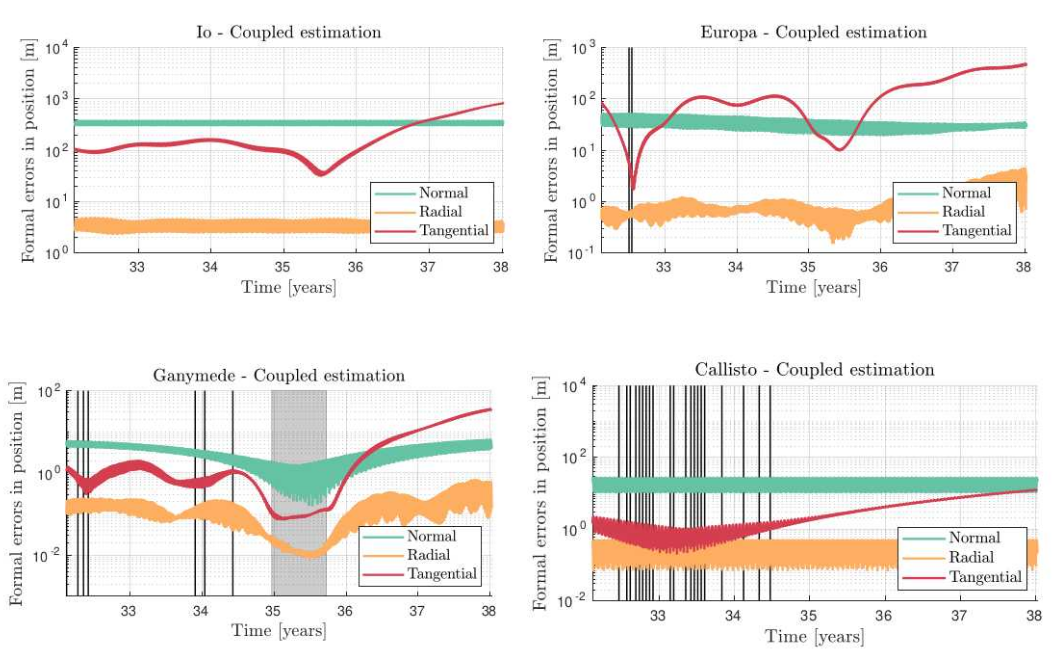
Fig. 2 Galilean satellite ephemeris uncertainty obtained from covariance analysis in a coupled estimation, using simulated JUICE radio tracking data [2]
- Interplanetary trajectory design using multiple gravity assists (MGA), deep space maneuvers (DSM), and shape-based low-thrust
Tudat includes a framework for interplanetary trajectory design (see Fig. 3 for example), where the typical MGA-DSM functionality is enhanced with shape-based (spherical shaping and hodographic shaping) legs. Although the interplanetary trajectory is evaluated/optimized using a (semi-)analytical inner loop, the numerical propagatio of Tudat allows for a direct verification of the final trajectory under perturbations and for the use of differential correction to generate a high-fidelity transfer orbit.
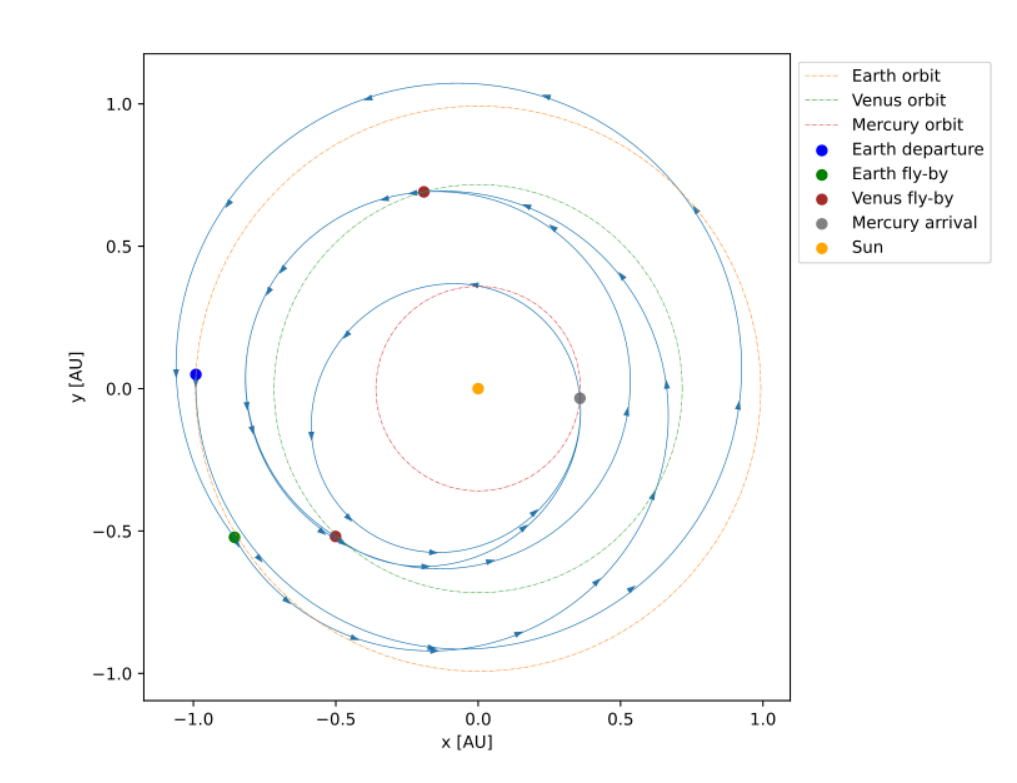
Fig. 3 Earth-Mercury transfer using EEVM sequence, one DSM per leg, in patched conic approximation(taken from one of the examples on the Tudatpy website)
Functionality
Tudat functionality falls into the following broad categories:
- Numerical propagation of dynamics, with modular setup and options for solar system bodies, accelerations, propagation schemes, etc. In addition to translation state, it can combine different types of dynamics for any number of bodies, including coupled orbital-rotational motion. No fundamental distinction is made between natural and artificial bodies, and the propagation is capable of both single- and multi-arc (or a combination). Tudat has a broad set of outputs (‘dependent variables’) that it can generate during numerical propagation that are useful for visualization/post-processing.
- State and parameter estimation: Tudat contains a large amount of functionality for performing (simulated) state and parameter estimation/covariance analysis from observational data. The framework is set up in a modular fashion, allowing for a combined analysis of a diverse set of types of observations and parameters. It has been used in a large number of simulation studies, with work ongoing to extend the functionality to processing DSN tracking data. It has been applied to the orbit determination of LRO, as well as to preliminary Doppler/VLBI data analysis of Mars and Venus Express.
- Mission design and optimization: Modules containing mission design tools, such as Lambert targeters and multiple gravity-assist transfers, are included in Tudat. Additionally, Tudat provides an interface to the Pagmo2 optimization software.
Documentation and development
In 2020, development of a Python interface, named TudatPy, was initiated. This has now become the default interface for Tudat and associated documentation, including:
- An installation and top-level user guide, supported by a growing set of example applications (https://docs.tudat.space/)
- Documentation for the Application Programmer Interface (API) of TudatPy (https://py.api.tudat.space/)
Both parts of the documentation now cover the core aspects of the functionality, and are being continuously expanded. At the time of writing, some C++ functions have yet to be exposed to Python, while other functions are missing their API documentation.
If you are interested in using or developing Tudat(py), you are most welcome to do so! Any questions about its functionality or suggestions for future implementation are always welcome, and can be addressed to the first author of this abstract. Tudat discussions primarily take place over Slack, open to any potential interested parties.
[1] Plumaris et al. (2022). "Cold Atom Interferometry for enhancing the Radio Science
gravity experiment: a Phobos case study" Remote Sensing, (submitted)
[2] Fayolle et al. (2022). "Decoupled and coupled moons’ ephemerides estimation strategies
Application to the JUICE mission" Planetary and Space Science, (revision submitted)
How to cite: Dirkx, D., Fayolle, M., Garrett, G., Avillez, M., Cowan, K., Cowan, S., Encarnacao, J., Fortuny Lombrana, C., Gaffarel, J., Hener, J., Hu, X., van Nistelrooij, M., Oggionni, F., and Plumaris, M.: The open-source astrodynamics Tudatpy software – overview for planetary mission design and science analysis, Europlanet Science Congress 2022, Granada, Spain, 18–23 Sep 2022, EPSC2022-253, https://doi.org/10.5194/epsc2022-253, 2022.
Abstract
The Gaia@home project is designed to give scientists another layer of freedom. The project makes possible to perform computations which demand a lot of CPU time – reducing the computational workload and opening up opportunities for heavy processing operations on volunteers computers.Gaia@home allows to create a huge number of small jobs (Gaia data + code), send them to the BOINC platform and collect the results for further analysis.Enjoy Gaia@home either if you are a scientist looking for CPU resources or a volunteer willing to contribute to citizen science.
Figure 1. Gaia@home logo.
Are you a scientist? Gaia@home can speed up your science!
- Step 1: Visit https://web.gaiaathome.eu/login and create an account
- Step 2: Prepare the code used for your calculations following some BOINC rules. Instructions are provided in our site. The code can compute any scientific problem which relies on the Gaia archive data, but also feel free to attach your own data.
- Step 3: Create a new task. Every task consists of the executable file, compiled according to BOINC guidance (step 2), auxiliary files (e.g. additional input file needed for any job) and a prescription on how to split Gaia archive into a series of parallel, independent jobs. Every BOINC job gets these files, and one portion of the data from the Gaia archive.
- Step 4: Your task starts running and you will be notified when a number of jobs on the BOINC platform have been completed.
- Step 5: You will be periodically notified by email about the status of your calculations. Finally, you will be notified when the task is completed and you are ready to download your results!
Figure 2. Screenshot of Gaia@home showing the current available computation resources from volunteers.
Would you like to contribute to citizen science? Volunteer your free resources!
- Step 1: Visit http://www.gaiaathome.eu and press on Volunteer now!
- Step 2: Create an account in BOINC
- Step 3: Install BOINC app in your device, and start contributing to science!
Acknowledgements
This work has received funding from European Space Agence under the polish industry incentive scheme - GAVIP-GridComputing (4000120180/17/NL/CBi).
TSR acknowledges funding from the NEO-MAPP project (H2020-EU-2-1-6/870377). This work was (partially) funded by the Spanish MICIN/AEI/10.13039/ the Institute of Cosmos Sciences University of Barcelona (ICCUB, Unidad de Excelencia ‘María de Maeztu’) through grant CEX2019-000918-M.
How to cite: Bartczak, P., Santana-Ros, T., Hypki, A., Langner, K., and Dudziński, G.: Gaia@home: Combining Gaia catalogue with the power of volunteer computing, Europlanet Science Congress 2022, Granada, Spain, 18–23 Sep 2022, EPSC2022-659, https://doi.org/10.5194/epsc2022-659, 2022.
In August 2020, Europlanet launched the Mentorship platform with the aim to support early career researchers. Two years after launch we are using a survey to gather feedback from mentors and mentees, and we are also following up with participants informally through chats and e-mails. The feedback so far has been positive and points to the effectiveness and the need of the programme to support the paths of early career researchers. We will present the Europlanet mentorship programme and the case study of the Romanian/Brazil collaboration that resulted from the mentor's work with two mentees. Europlanet 2024 RI has received funding from the European Union's Horizon 2020 research and innovation programme under grant agreement No 871149.
How to cite: Stonkute, E., Tautvaisiene, G., Heward, A., and Mikolaitis, S.: Europlanet Mentorship programme: opportunities for sharing the knowledge, Europlanet Science Congress 2022, Granada, Spain, 18–23 Sep 2022, EPSC2022-808, https://doi.org/10.5194/epsc2022-808, 2022.
Abstract
Objectives for Phase II of NASA’s Artemis Program include establishment of lunar surface infrastructure to support a sustainable, long-term human presence on the Moon. Terrestrially, awareness of climate impacts from cement and concrete production has led to renewed interest in traditional building materials using earthen and pozzolanic binders with locally sourced aggregates [1, 2, 3]. In remote, austere and resource-constrained environments, use of site-sourced materials is often an economic necessity in addition to being valuable for local autonomy and self-sufficiency. This study evaluates modifications to ASTM cement mortar testing methods, incorporating details from European standards for earthen plasters and lime-based mortars. Development of consistent, simplified methods for evaluating in-situ materials will be essential not only for meeting future climate goals and sustainable construction needs, but also for conducting autonomous robotic manipulation and evaluation of regolith construction materials.
Introduction:
Recent studies of in-situ derived simulant-based building materials for construction on the surface of the Moon and Mars have drawn on traditional building techniques and their renewed use in sustainable construction [4, 5]. Humans have experience spanning millennia building with site soils and locally-derived mineral materials. In addition to examples found at archaeological sites and historic buildings surviving to the present, some earthen building traditions (adobe, mud plastering) continue to be practiced to this day [6, 7], while others are seeing broader adoption in innovative construction techniques using 3D printing [8, 9].
In this study, a selection of these formulations were adapted for use with planetary analog site soils to assess the suitability of these methods in evaluating potential regolith construction materials for in-situ construction on planetary surfaces [10]. These studies focused on curing and compressive strength testing of preliminary mix formulations using small mortar specimens in ambient conditions.
Materials Testing Methods for Mortars and Extruded Materials:
Basic evaluations of soil-based building materials begin with particle size distribution and compressive strength. In North America, these assessments are often conducted following ASTM C-109, “Standard Test Method for Compressive Strength of Hydraulic Cement Mortars (Using 2-in. or [50 mm] Cube Specimens)” [11] in conjunction with ASTM C-144 (Standard Specification for Aggregate for Masonry Mortar) [12] and ASTM C-136 (Standard Test Method for Sieve Analysis of Fine and Coarse Aggregates) [13]. Key details of ASTM C109 requiring submersion of specimens in water during curing preclude its use with non-cementitious binders. Techniques used in evaluation of traditional clay plasters (DIN 18947) [14], lime mortars (EN 1015) [15] and pozzolanic materials were adapted here for use with specimens prepared from construction site mixes using local soils, industrial byproducts, organic additives and bagged materials from masonry and ceramic suppliers.
Key Findings & Opportunities:
Drawing upon European standards for traditional building materials and sustainable building products to modify ASTM methods can enable study of site-sourced, minimally-processed non-cement materials for terrestrial and planetary surface construction. Experience in refining these methods alongside researchers in sustainable construction demonstrates that: 1) tradespeople and craft builders in traditional construction have a valuable contribution to offer to the study of materials for in-situ construction on planetary surfaces, and 2) that development of consistent, simplified methods for use in preliminary testing of varied simulant and in-situ soil formulations for construction may enable opportunities for interdisciplinary collaboration with mutual benefits for terrestrial sustainable building and in-situ regolith construction on the Moon and Mars.
References:
[1] Delinière, R., Aubert, J. E., Rojat, F., & Gasc-Barbier, M. (2014). Physical, mineralogical and mechanical characterization of ready-mixed clay plaster. Building and Environment, 80, 11-17.
[2] MacDougall, C., & Vardy, S. (2014). Mechanical performance of lime-cement mortar for straw-bale construction. Journal of Green Building, 9(3), 100-115.
[3] Seitz, S., Haynes, R. & Glass, B. “Playing With DIRT: Building the Framework for a Comprehensive Materials Database.” ASCE Earth & Space 2022 Conference, Denver, Colorado.
[4] Rosa, I., Coto, A., Allende, M. I., Lepech, M. D., & Loftus, D. J. (2021). Designing Biopolymer-Bound Regolith Composites for Maximum Compressive Strength. Earth and Space 2021, 200-214.
[5] Karl, D., Duminy, T., Lima, P., Kamutzki, F., Gili, A., Zocca, A., Günster, J. and Gurlo, A., 2020. Clay in situ resource utilization with Mars global simulant slurries for additive manufacturing and traditional shaping of unfired green bodies. Acta Astronautica, 174, pp.241-253.
[6] Taylor, B., Vardy, S., & MacDougall, C. (2006). Compressive strength testing of earthen plasters for straw bale wall application. In Advances in Engineering Structures, Mechanics & Construction(pp. 175-183). Springer, Dordrecht.
[7] Faria, Paulina, and Vitor Silva. "Natural hydraulic lime mortars: influence of the aggregates." Historic Mortars. Springer, Cham, 2019. 185-199.
[8] Mueller, R. et al. (2019). “NASA Centennial Challenge: 3D Printed Habitat, Phase 3 Final Results.” 70th International Astronautical Congress (IAC), October 21-25, 2019, Washington, DC.
[9] Biggerstaff, A., Fuller, G., Lepech, M., & Loftus, D. (2021). Determining the yield stress of a Biopolymer-bound Soil Composite for extrusion-based 3D printing applications. Construction and Building Materials, 305, 124730.
[10] Seitz, S. (2019). “Building Materials for the Moon & Mars: Mortar Testing Methods for Regolith.” ASCE EMI – MS99, Pasadena, CA.
[11] ASTM (2021). ASTM C109 - Standard Test Method for Compressive Strength of Hydraulic Cement Mortars (Using 2-in. or (50-mm) Cube Specimens).
[12] ASTM (2021). ASTM C136 - Standard Test Method for Sieve Analysis of Fine and Coarse Aggregates. West Conshohocken, Pennsylvania: ASTM International.
[13] ASTM (2021). ASTM C144 - Standard Specification for Aggregate for Masonry Mortar. West Conshohocken, Pennsylvania: ASTM International.
[14] Deutsches Institut Fur Normung E.V. (2018). “DIN 18947 - Earth plasters – Requirements, test and labelling.” https://dx.doi.org/10.31030/2897115.
[15] EN 1015-11:1999; Methods of Test for Mortar for Masonry—Part 11: Determination of Flexural and Compressive Strength of Hardened Mortar. BSI.
How to cite: Seitz, S., MacDougall, C., and Glass, B.: Enabling Evaluation of In-Situ Regolith-Based Construction Materials with Modified Methods for Testing Compressive Strength of Non-Cement Mortar Specimens Using Simulants & Analog Site Soils, Europlanet Science Congress 2022, Granada, Spain, 18–23 Sep 2022, EPSC2022-1092, https://doi.org/10.5194/epsc2022-1092, 2022.
The Webb Space Telescope, a worldwide mission proposing exceptional scientific advances, was launched in Kourou on December 25, 2021. For the project Guiana to the Stars, a team of ten researchers from French laboratories involved in the mission - Paris Observatory - PSL, CEA and IAS - with the support of the science outreach association SpaceBus France, took advantage of this opportunity to reach out to citizens and promote science-society dialogue around astronomy.
From December 5 to 22, 2021, our group of scientists crisscrossed French Guiana. They explained the major challenges and expectations related to the launch of the new telescope in space, with the following objectives:
- To introduce people to astronomy and science through playful, interactive, and accessible animations.
- To demonstrate the scientific method and develop critical thinking through a rich program of conferences.
- To testify of the cultural richness and the international aspect of space-related professions.
- To create vocations and promote the place of women in science to fight against their under-representation in this sector.
The Guiana to the Stars tour covered 2,500 kilometers, in 12 cities through 60 events. The team visited schools, markets, villages, social centers, touristic spots, public places, and the Guiana Space Center. All along the route, we planned animations and activities adapted to the audiences encountered:
- For primary through high school students, the team of scientists proposed science workshops around space and astronomy. These workshops were also an opportunity for the students to meet and exchange with astrophysicists, in particular about space-related professions.
- For teachers of all levels, two astronomers of the Observatoire de Paris - PSL provided academic training in astronomy through general courses, activities, and initiations to night sky observations.
- For the public, astrophysicists gave astronomy conferences and led educational activities and night-time observations. These were proposed free of charge in public places, in the afternoon and in the evening, with the support of the mediators of the Canopée des Sciences.
Ambitious and original, this science outreach operation received the support of the President of the Territorial Collectivity of Guyana. It is placed under the high patronage of the French Minister of Overseas Territories and is sponsored by the French Minister Delegate in charge of Citizenship.
The Guiana to the stars project is carried by Alain Doressoundiram, researcher at the Observatoire de Paris - PSL, and Raphaël Peralta, researcher at the CEA and president of the SpaceBus France association. It has received financial and logistical support from the CEA, the Observatoire de Paris - PSL, the SpaceBus France association, the Académie de Guyane, the Canopée des Sciences, the CNES, the Maison pour la Science en Guyane, the French Government, the CNRS, the Université Paris Science et Lettres, the OSUPS, the SF2A, the IAS, the Unistellar company, the Collectivité Territoriale de Guyane and the Main à la Pâte foundation.
The whole program of the tour can be found on: https://www.jwst.fr/la-guyane-vers-les-etoiles/
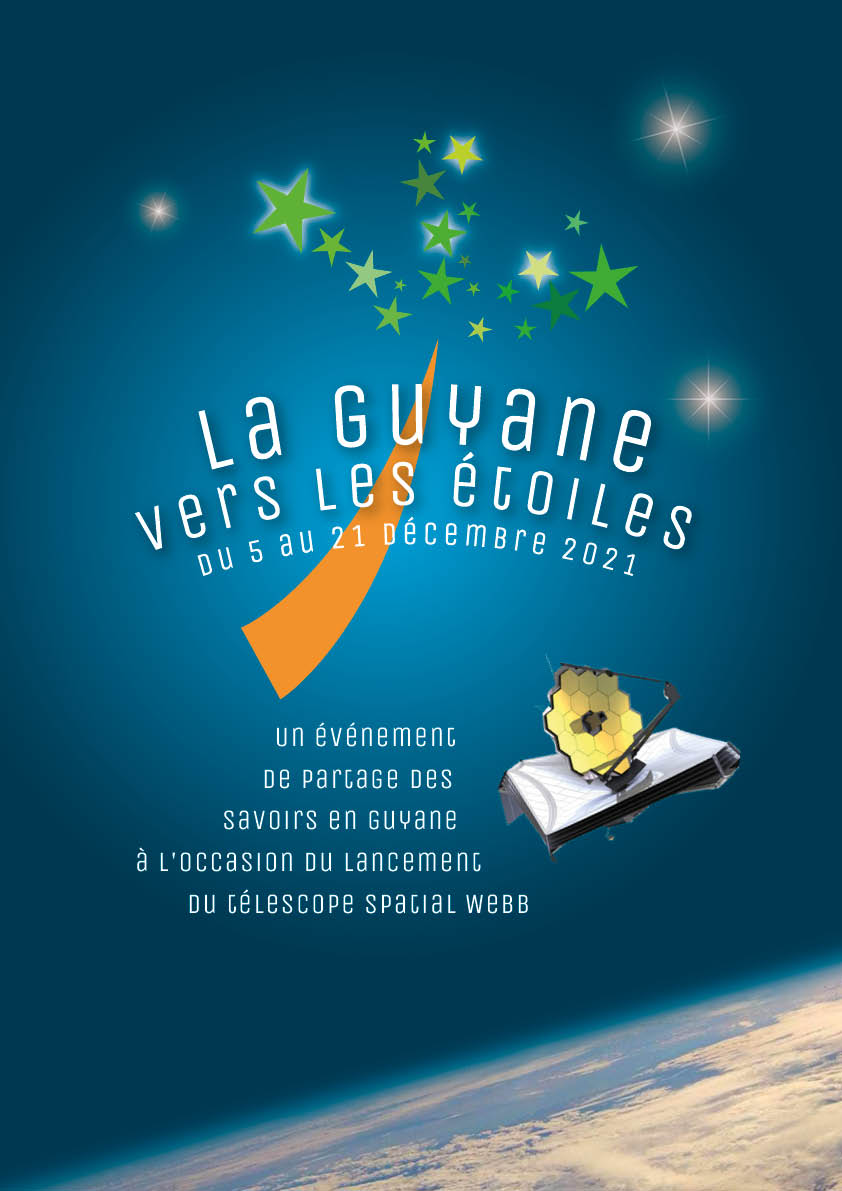
How to cite: Peralta, R. and Doressoundiram, A.: Guiana to the Stars: science outreach tour for the Webb space telescope launch, Europlanet Science Congress 2022, Granada, Spain, 18–23 Sep 2022, EPSC2022-1182, https://doi.org/10.5194/epsc2022-1182, 2022.
Please decide on your access
Please use the buttons below to download the presentation materials or to visit the external website where the presentation is linked. Regarding the external link, please note that Copernicus Meetings cannot accept any liability for the content and the website you will visit.
Forward to presentation link
You are going to open an external link to the presentation as indicated by the authors. Copernicus Meetings cannot accept any liability for the content and the website you will visit.
We are sorry, but presentations are only available for users who registered for the conference. Thank you.
Please decide on your access
Please use the buttons below to download the presentation materials or to visit the external website where the presentation is linked. Regarding the external link, please note that Copernicus Meetings cannot accept any liability for the content and the website you will visit.
Forward to session asset
You are going to open an external link to the asset as indicated by the session. Copernicus Meetings cannot accept any liability for the content and the website you will visit.
We are sorry, but presentations are only available for users who registered for the conference. Thank you.

